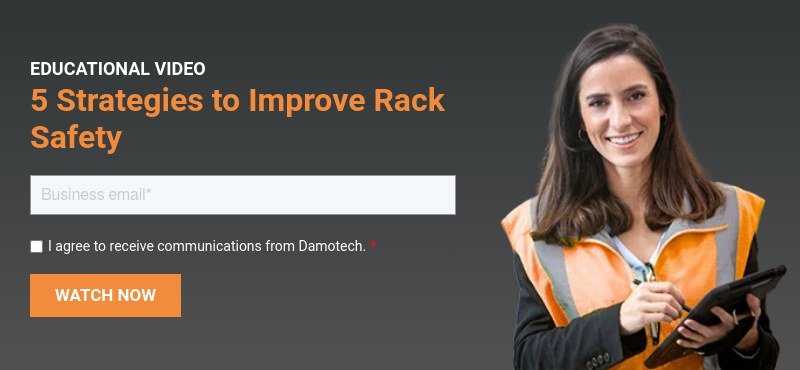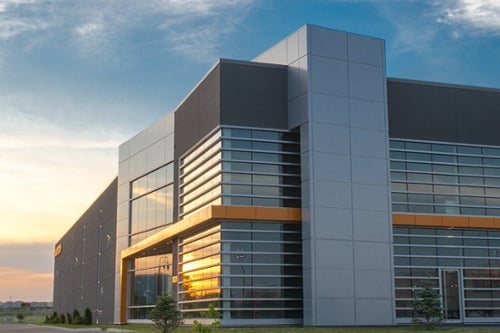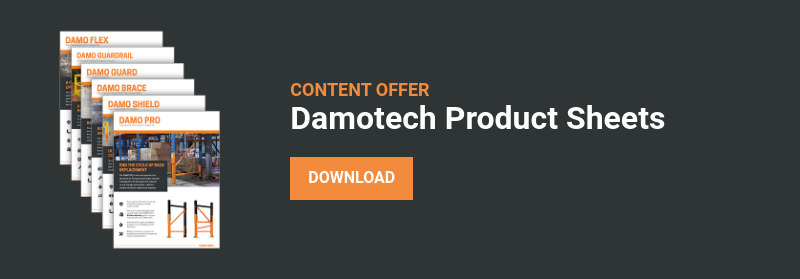Rack safety is a complicated issue to tackle. Where should we start? Damotech recently recorded a webinar to address the 5 strategies that matter most when it comes to achieving rack safety in your warehouse. This article provides a summary of what our experts covered during the session. You can also watch the 20-minute video recording if you prefer:
Our 5 Strategies to Improve Rack Safety
Because a warehouse is in constant flux, rack safety is an ongoing process. There is no one way to start, and it is never really over. Here is what we propose:

It might sound very straightforward, but if you manage to do all these things, your racks will be in better shape, and your warehouse will become much safer.
1. Start With Regular Inspections
The only way to know where you stand is to start with the inspection. Either it is performed by your trained employees (more on that in a minute) or a third party. The inspections must be regular and done by walking the facility and carefully observing the racking. Impact sensors on forklifts or directly on the rack can't always sense damage due to rubbing pallets on columns and braces or alerting you to dislodged safety bars and safety pins. There is no other way to know if your racks are compliant. Inspections are not only for finding damage, by the way. The racks may have been modified since the initial installation or you've lost count of who did what and where.
Frequency depends on the activity in your warehouse and level of safety culture. Emphasis should be placed on inspecting the racks regularly and reporting the damage.:
Daily or Weekly, if there is a lot of activity or heavy forklift traffic. It could be done in specific aisles or zones considered high risk, such as a shipping/loading area.
Monthly or Quarterly: these inspections can be scheduled and conducted by trained personnel.
Annually: This is the long one, and you might consider asking an expert for help, either to get a baseline survey or to measure your progress from year to year.
2. Take Action
Once you know where the damage is located, you want to prioritize and address the issues. Take action means having a plan. But not all problems are equal. The hardest part for your inspectors will be figuring out the priority of an issue in order to know what needs to be addressed first. Unfortunately, the design codes are not clear on this. If you've mandated a third-party to inspect your racks, make sure they supply you with a list of priorities. We keep it simple with these four priority levels: Unload, High Priority, Medium Priority and Low Priority. So, the best way to go about this is not to try to boil the ocean, as we say. We all have limited budgets and limited time, so fix the issues that are the most critical first.
You can repair or replace the damaged upright. If you are replacing with OEM parts, ensure that you are replacing components like for like. The alternative is to repair. For more on this, download our comparison or read about the advantages here. Whomever you choose as your supplier, make sure that the repair solution you choose is an engineered solution that maintains the original configuration of the rack and restores it's load capacity.
3. Protect Your People and Assets
Once we've taken action, we want to be proactive about protecting the most critical aspects of our facility: people, products, and assets. Consider putting column guards and end of row protection where traffic is heaviest. Protect the lower part of the uprights, where it is likely to get hit. Make sure pedestrian walkways are designated and protected with guardrails. The use of accessories for the protection of falling objects is also a must (wire mesh decking, panels, netting, safety bars, etc.)
4. Offer Rack Safety Training to Employees and Forklift Drivers
Now that the most critical issues are under control or scheduled to be, you want to elevate awareness and knowledge about rack safety by training your workforce, so they can take on the responsibility of identifying damage and ensuring rack safety. You want to help them understand the consequences of accumulated damage. Training should cover inspection procedures if you want your workers to perform regular inspections. It should aim to bring awareness of regulations, like the building code, rack design codes, and fire safety code.
According to OSHA, effective training can reduce accidents involving forklifts by 25% to 30%. This is very significant when you think of the little investment vs the benefits.
Some of the benefits of training are:
- Reduced injuries and maintenance costs
- Reduced liability / lowered insurance premiums
- Less damage to property, products, equipment
- Extend the life of racks
- Avoid OSHA fines
5. Track and Report
Finally, because rack safety is ongoing, we want to report and keep a documented history of what is happening to the racking and bring accountability to the process. Tracking and reporting issues brings clear communication through the chain of command, making sure that every level is informed. This, in turn, drives accountability for the observed issues. With a clear accountability process, all are informed, and things should get done. Plus, tracking and reporting will build you a timeline.
Always keep these documents on hand: LARCs - Load Application and Rack Configuration drawings, inspection reports, list of all known issues, any modifications & repairs, and employee training records.
The Damotech Platform can help managers with this process. It can help them access crucial rack data from virtually anywhere! Accessible via the cloud, racking issues can be tracked easily with a real-time dashboard. Watch the demo to see how the Damotech Platform can help modernize the way rack inspections are managed at your company.
Your Next steps...
You can take this quiz to get your pallet rack safety score. Then, find a reliable partner that can help you navigate the process of improving rack safety and finally, download some free tools such as a damage assessment guide, a rack safety poster and a sample inspection checklist. As Marc mentioned during the webinar, taking action is the hardest part. Hopefully, these strategies will help you to get started.







